SuperMaze動物行為視頻分析軟件原理及應用領域
SuperMaze動物行為視頻分析系統原理及應用領域
SuperMaze 動物行為軌跡分析平臺是一套通過視頻攝像機和計算機,采用圖像處理技術,自動跟蹤和記錄動物活動的通用型運動軌跡記錄分析系統,可以應用在神經藥理,學習記憶藥理,抗衰老藥理和新藥神經系統一般藥理毒理研究,也可用于神經科學基礎研究。
SuperMaze適用于Morris水迷宮實驗、開場實驗、曠場實驗、自發活動、避暗實驗、T型迷宮、Y型迷宮、放射型迷宮、高架十字迷宮、八臂迷宮、Barnes迷宮、條件性位置偏愛實驗、Zero迷宮、孔洞實驗、跳臺實驗、新物體識別等各種動物實驗。
SuperMaze除了具有自動跟蹤記錄動物活動軌跡的基本功能外,還具有通過事件記錄器記錄視頻系統無法自動識別的各項動物行為事件、軌跡數據導入再分析、實驗數據管理以及實時錄像功能,并能夠接收16路外部輸入信號,控制12路外部輸出信號,充分體現了自動化與靈活性相結合的優勢。
SuperMaze設置簡單、操作靈活,具有很高的性能價格比。
系統功能
● 可隨心設計的平臺區域圖形(平臺軟件開放),開展各種行為學實驗
● 穩定可靠的頭、中、尾三點跟蹤算法,甚至可以可識別果蠅幼蟲
● 可以對動物的主動行為、學習記憶、條件反射、反應性、被動行為中的各種行為學數據進行采集處理
● 獨創的事件統計和分析功能,實驗結果一目了然
● 可視化的實驗數據管理功能,安全便捷
● 強大的綜合報表功能,并支持一鍵導出
● 靈活的實驗啟動和結束方式,提高實驗效率
● 內置方便快捷的手動事件記錄器,記錄動物各種行為特征
● 自定義實驗動物的屬性模板 ,實驗參數更豐富全面
● 軟件擴展齊全,最高支持16通道的實驗分析
● 控制器可以兼容國外知名行為學廠家儀器,技術國內領先
應用領域(開展的實驗)
1. Morris水迷宮(Morris water maze, MWM)
Morris水迷宮實驗是一種強迫實驗動物(大鼠、小鼠)游泳,學習尋找隱藏在水中平臺的一種實驗,Morris水迷宮主要用于測試實驗動物對空間位置感和方向感(空間定位)的學習記憶能力,被廣泛應用于學習記憶、老年癡呆、海馬/外海馬研究、智力與衰老、新藥開發/篩選/評價、藥理學、毒理學、預防醫學、神經生物學、動物心理學及行為生物學等多個學科的科學研究和計算機輔助教學等領域,在世界上已經得到廣泛地認可,是醫學院校開展行為學研究尤其是學習與記憶研究的首選經典實驗。
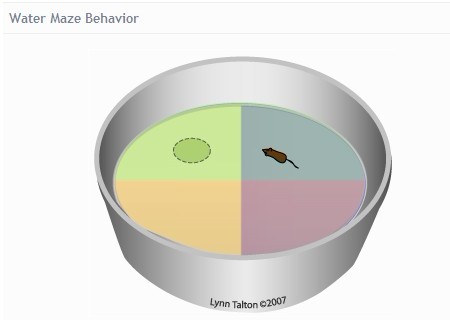
2. T迷宮實驗(T-maze)
T迷宮由1條干和2條臂構成。迷宮使動物在獲取食物獎勵時沒有任何參考,只能根據自我判斷選取食餌正確擺放一端。一般在測試前幾天對其食量進行限制,測試前2天對動物進行訓練。之后進行正式測試,每日連續測試15次,每次測試間隔1min,共測3d。
The T-maze is a choice task. The subject is placed in the base of the "T". Following a short delay, it is allowed to explore the maze and choose to enter either the right or left arms. The choice is scored according to variety of criterion, including spontaneous alternation, cued reward, or to indicate a preference. Based on the criterion used in an experiment, the T-maze can be used to test learning and memory, preferences for stimuli or reward, or spontaneous alternation behavior.
3. 八臂迷宮(Radial Arm Maze)
Subjects are placed in the center of an eight-arm radial maze. Four randomly chosen arms are baited with food pellets in opaque containers. The subject is given the opportunity to visit all the arms and collect all the available food pellets. After a rentention delay, the subject is returned to the maze. In win-stay conditions, the same four arms are baited, and the number of correct choices the subject makes in collecting the pellets is recorded. In win-shift conditions, the four arms NOT baited in the earlier trial are now baited, and the number of correct arm choices is recorded. Each day, a new set of four arms is chosen randomly.
八臂迷宮用來檢測藥物或大腦受損狀態下學習和記憶方面的表現,它由八個完全相同的臂組成,這些臂從一個中央平臺放射出來,所以又被稱為放射迷宮每個臂盡頭有食物提供裝置,根據分析動物取食的策略即進入每臂的次數、時間、正確次數、錯誤次數、路線等參數可以反映出實驗動物的空間記憶能力。相對而言,八臂迷宮操作簡便、可行,而且能區分短期的工作記憶和長期的參考記憶,現已被廣泛用于學習記憶功能評價。
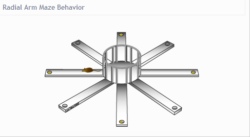
4. 自主活動、曠場實驗(Open Field)
The subject is placed in the activity chamber for a specified time period. Activity levels and movement in three dimensions are recorded by the activity system and can be analyzed for evidence of hyperactiviy, hypoactivity, anxiety, explorative behaviors, and stereotyped rotation.
自發活動曠場曠場分析系統是觀察研究實驗動物神經精神變化、進入開闊環境后的各種行為,例如動物對新開闊環境的恐懼而主要在周邊區域活動,在中央區域活動較少,但動物的探究特性又促使其產生在中央區域活動的動機,也可觀察由此而產生的焦慮心理。中樞興奮藥物可以明顯增加自主的活動而減少探究行為,一定劑量的抗精神病藥物可以減少探究行為而不影響自主活動。
5. 高架十字迷宮(Elevated Plus Maze)
高架十字迷宮是利用動物對新異環境的探究特性和對高懸敞開臂的恐懼形成矛盾沖突行為來考察動物的焦慮狀態。高架十字迷宮具有一對開臂和一對閉臂,高架十字迷宮距離地面較高,相當于人站在峭壁上,使實驗對象產生恐懼和不安心理。高架十字迷宮被廣泛應用于新藥開發、藥理學、毒理學、預防醫學、神經生物學、動物心理學等多個學科的科學-研究和計算機輔助教學等領域,是醫學院校與科研機構開展焦慮抑郁研究的經典實驗。
The animal is placed in the center of the apparatus and observed for a set time. Measurements compare the include total time spent in the open and closed arms (and central platform) as well as entries into the open and closed arms.
6. 黑白箱實驗(light dark box)
The subject is placed in the dark portion of the box for a set period of acclimation time. At the end of this period, a door separating the two compartments is opened. The amount of time that the subject takes to emerge fully from the enclosed area into the open area is measured.
7. 社交行為實驗(social interaction)
The subject is habituated to the test chamber and allowed to freely explore for a set time. A novel animal is placed in one of the two enclosures, and the percentage of time the mouse spends in the section with the novel animal is compared to the time spent in the section with the empty enclosure. In a later session, the time spent with the same animal might be compared to time spent with a newer, more novel animal.
8. 條件性位置偏愛(Conditioned Place Preference)
條件性位置偏愛實驗(CPP)實驗是目前評價藥物精神依賴性的經典實驗模型。該實驗將實驗動物(大鼠、小鼠)置于條件性位置偏愛箱的白色觀察區,并給予精神依賴性藥物然后觀察實驗動物在條件性位置偏愛箱的黑色區和白色區的活動情況,白色區、黑色區以及其中的灰色區之間有小門可供動物自由穿梭。動物每次處于給藥區就會在藥物獎賞性效應的作用下對黑色和白色區域產生位置上的偏好,其程度與藥物的精神依賴性相關。
A drug is injected and the subject is introduced to distinctive environment A. This procedure is repeated for several trials. During these conditioning trials the animal develops an association between the subjective state produced by the drug (often drugs that produce mood elevation or euphoria in humans) and the contextual cues present while the drug is active. To test the conditioning, the animal is placed in an apparatus with drug-related cues in one compartment and neutral cues in the other. nbsp; If conditioning occurred, the animal will move toward the compartment containing the drug-related cues.
In a Conditioned Place Preference experiment, subjects are returned to an apparatus were they can freely move between a compartment in which they were conditioned with drug-related cues, and a compartment with neutral cues. If the conditioning was successful for positive, reinforcing drug states, they should spend more time in the compartment with drug-related cues。
In a Conditioned Place Aversion experiment, subjects are returned to an apparatus were they can freely move between a compartment in which they were conditioned with an aversive stimulus, such as a shock; and a compartment with neutral cues. If the aversive conditioning was successful, they should spend more time in the compartment with neutral cues.
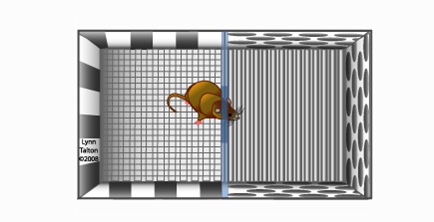
9. 強迫游泳(force swim test)、懸尾實驗(tail test)
Since some mutations cause a deficit in swimming ability, the forced swim test can be used to demonstrate normal swimming and floating ability. The test is most frequently used to examine the "learned helplessness" response common in animal models of depression.
The subject is suspended by the tail for a set interval the percentage of time the subject spends still versus moving is examined for evidence of the "learned helplessness" response common in models of depression.
懸尾實驗主要用于抗抑郁、鎮靜以及止痛類藥物的研究。懸尾實驗系統適用于大鼠、小鼠或其他實驗室動物,通過固定動物尾部使其頭向下懸掛,記錄處于該環境的動物產生絕望的不動狀態過程中的一系列參數。
10. 條件性恐懼實驗(fear conditioning)
條件性恐懼分析用于小型嚙齒類動物(大、小鼠)環境相關條件性恐懼實驗研究。抗抑郁藥和抗中樞興奮藥可以明顯縮短不動狀態持續的時間。實驗過程中,實驗對象被給與一個聲音信號,隨后給予電擊刺激。該訓練稱為條件性訓練,訓練結束后實驗動物進行聲音信號或環境聯系性實驗。一般情況下嚙齒類動物對相應的環境和不同環境下同樣的聲音信號都會做出明顯的條件性恐懼反應,如靜止不動。
The Pavlovian Fear Conditioning task allows for the assessment of learning and memory regarding aversive events. The task allows for the simultaneous assessment of learning about simple, unimodal cues and learning about complex, multimodal stimuli such as context. Fear conditioning universally depends on the integrity of the amygdala, but context conditioning is sensitive to manipulations of the hippocampus. This task has been used extensively to demonstrate both genetically based impairments and enhancements in learning and memory.
11. 震驚條件反射(startle and pre-pulse inhibition)
|
Basic Startle Response
|
|
In basic startle, startle stimuli of various intensities are presented unexpectedly. Varying startle response and habituation are recorded.
|
|
|
|
Pre-Pulse Inhibition
|
|
In Pre-Pulse Inhibition (PPI), the startle stimulus is paired with a predictive cue. In normal subjects, the "pre-pulse" cue reduces the startle amplitude. This inhibition of the startle response is known as PPI. Humans and animal models of several disease states are known to have pre-pulse inhibition deficits, including schizophrenia, Alzheimer's, and PTSD.
|
|
Fear-Potentiated Startle
|
|
In Fear-Potentiated Startle, the subjects are trained to associate a neutral stimulus, such as a light cue, with an aversive stimulus. When the startle response is tested in the presence of the light cue, the startle amplitude should be potentiated, or increased.
|
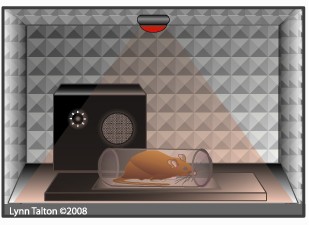
12.新穎物體識別(novel object recognition)
The subject is habituated to the test chamber and allowed to freely explore for a set time.
A novel object is placed in one of the two enclosures, and the percentage of time the mouse spends in the section with the new object is compared to the time spent in the section with the empty enclosure. In a later session, the time spent with the same object might be compared to time spent with a newer, more novel object.
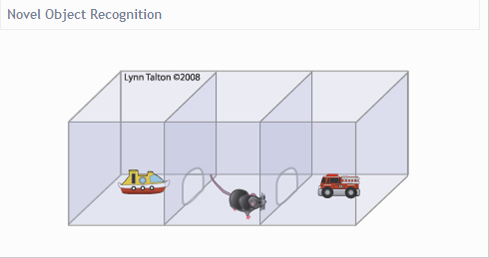
Copyright(C) 1998-2025 生物器材網 電話:021-64166852;13621656896 E-mail:info@bio-equip.com





